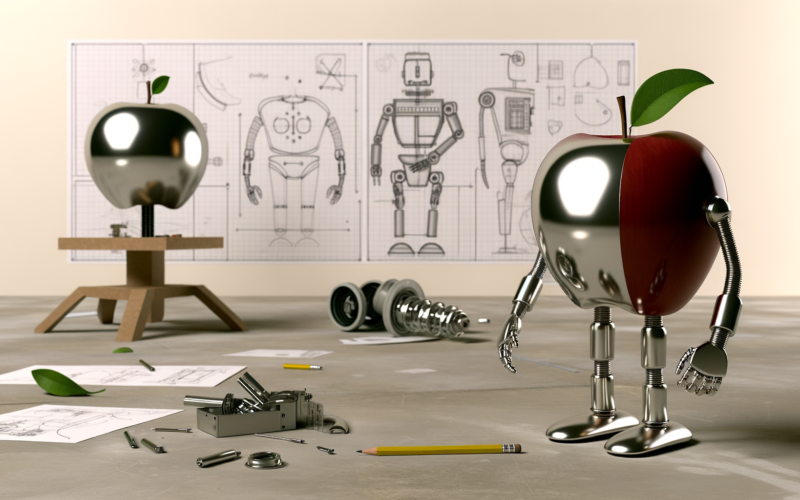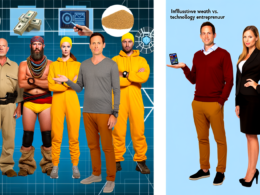Apple explores AI-powered robotics, including a desktop assistant and advanced Siri. Could a lifelike “Pixar Lamp” arrive soon? 🤖 #Apple #AI #Robotics
- Introduction: Apple’s Bold Leap into Robotics and AI
- The Evolution of Apple’s AI and Robotics Journey
- Main Insights on Apple’s Robotics Ambitions
- Challenges in Bringing Robotics to Market
- The Future of AI-Powered Robotics at Apple
- Final Reflections on Apple’s Robotics Revolution
Introduction: Apple’s Bold Leap into Robotics and AI
In a rapidly evolving technological landscape, Apple is taking daring strides into the world of robotics and artificial intelligence. This ambitious venture marks a significant shift in Apple’s strategic focus, aiming to redefine how we interact with technology in our daily lives. As AI and robotics become increasingly intertwined with consumer electronics, Apple’s exploration in this domain could lead to groundbreaking innovations that not only enhance user experience but also set new industry standards. This article delves into Apple’s current endeavors in robotics, the implications of these advancements, and what the future might hold for AI-powered automation.
The Evolution of Apple’s AI and Robotics Journey
Apple’s journey into AI and robotics is far from a sudden leap; it is a calculated step rooted in the company’s rich history of innovation in hardware and software integration. Historically, Apple has been at the forefront of technological evolution, from the introduction of the Macintosh in 1984 to the revolutionary iPhone in 2007. Each product launch has been a testament to Apple’s commitment to seamless integration and user-centric design.
Apple’s entry into AI began subtly with the introduction of Siri in 2011. As one of the first virtual assistants, Siri represented Apple’s initial foray into artificial intelligence, setting the stage for future advancements. Over the years, Apple has continued to refine Siri’s capabilities, gradually incorporating more sophisticated AI technologies to enhance its functionality. These developments laid the groundwork for Apple’s current exploration of robotics.
In recent years, the tech giant has strategically acquired several AI-focused companies, bolstering its capabilities in machine learning, natural language processing, and computer vision. These acquisitions underscore Apple’s intent to expand beyond traditional consumer electronics into the realm of intelligent automation and robotics. The company’s current projects, like the rumored “Pixar Lamp” robot, are evidence of its commitment to pioneering the next wave of technological innovation.
Main Insights on Apple’s Robotics Ambitions
The Pixar Lamp: A Glimpse into the Future
One of the most intriguing developments in Apple’s robotics journey is the prototype codenamed J595, colloquially known as the “Pixar Lamp.” Drawing inspiration from the animation studio’s iconic lamp, this robotic assistant is designed to be more than just a smart device. With a swiveling screen mounted on a robotic arm, the Pixar Lamp aims to offer a more dynamic interaction with users, capable of following conversations and tracking users during video calls. This innovation represents a significant leap in making technology feel more personal and intuitive.
The Role of AI in Apple’s Robotics Vision
AI is at the heart of Apple’s robotics ambitions, with a focus on creating devices that can learn and adapt to user behavior. Apple’s proprietary “Charismatic” software platform is designed to facilitate voice-first commands, facial recognition, and personalized content delivery. By harnessing the power of AI, Apple aims to develop robots that can seamlessly integrate into the home environment, enhancing user experience through intelligent automation and interaction.
Expanding the Smart Home Ecosystem
Apple’s exploration of robotics is closely tied to its vision for a comprehensive smart home ecosystem. The company’s future products are expected to extend beyond traditional smart speakers and displays, incorporating advanced robotics to offer a more holistic approach to home automation. From lifelike assistants to mobile bots with wheels, Apple’s robotics lineup could revolutionize how we manage our homes, blending convenience with cutting-edge technology.
The Industrial Potential of Apple’s Robots
Beyond the consumer market, Apple is exploring the industrial applications of its robotics technology. The development of humanoid robots for industrial use suggests that Apple is looking to tap into new markets, leveraging its expertise in hardware and software integration to offer solutions that enhance productivity and efficiency in industrial settings.
Challenges in Bringing Robotics to Market
Technical and Ethical Considerations
While Apple’s robotics ambitions are promising, several challenges must be addressed before these products can become mainstream. One of the primary technical challenges is ensuring the reliability and safety of AI-powered robots. As these devices are designed to interact closely with humans, any malfunction could have significant consequences. Apple must prioritize rigorous testing and safety protocols to build consumer trust in its robotics products.
Ethical considerations also play a crucial role in the development and deployment of AI and robotics. Issues such as data privacy, security, and the ethical use of AI must be carefully navigated to avoid potential pitfalls. Apple’s reputation for prioritizing privacy and security could serve as a strong foundation for addressing these concerns, but ongoing vigilance will be essential.
Market Readiness and Consumer Acceptance
Another significant challenge is gauging market readiness and achieving consumer acceptance. While the idea of robotic assistants is enticing, widespread adoption will depend on factors such as affordability, ease of use, and perceived value. Apple must carefully consider these aspects to ensure its robotics products appeal to a broad audience and align with consumer expectations.
The Future of AI-Powered Robotics at Apple
Emerging Trends and Predictions
Looking ahead, Apple’s foray into robotics could catalyze a new era of innovation in AI-powered automation. As technology continues to advance, we can expect to see more sophisticated and versatile robotic solutions that blur the lines between the digital and physical worlds. Apple’s commitment to thoughtful design and user experience will likely drive the development of robots that are not only functional but also aesthetically pleasing and intuitive to use.
The Impact on the Tech Industry
Apple’s entry into the robotics market could have far-reaching implications for the tech industry as a whole. By setting new standards for innovation and integration, Apple could inspire other companies to explore the potential of AI and robotics, leading to increased competition and collaboration. This, in turn, could accelerate the development of cutting-edge technologies and spur new business models across various sectors.
Final Reflections on Apple’s Robotics Revolution
In conclusion, Apple’s exploration of robotics represents a bold step into the future of technology. By leveraging its strengths in hardware and software integration, Apple has the potential to redefine how we interact with machines, bringing us closer to a world where AI-powered robots are an integral part of our daily lives. While challenges remain, Apple’s track record of innovation and commitment to user experience suggest that its robotics ambitions could pave the way for a new era of intelligent automation. As we look to the future, the possibilities for AI and robotics at Apple are limitless, promising to transform industries and enhance the way we live and work.











